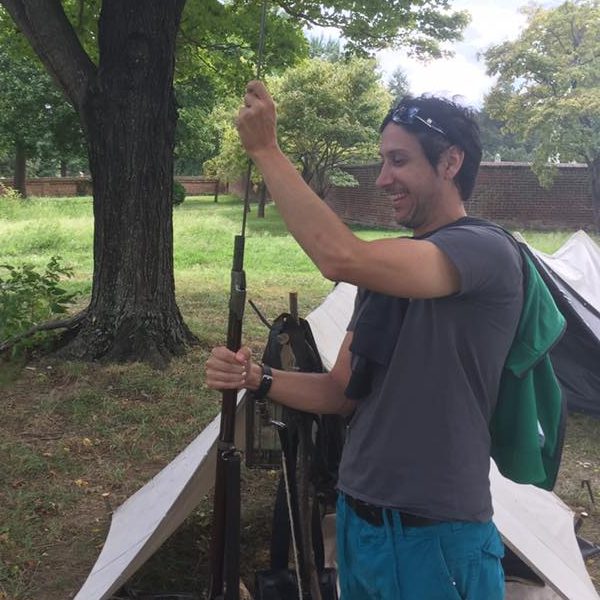Podcast: Play in new window | Download
Subscribe: Apple Podcasts | RSS
Welcome, Pete Bevelacqua of Antenna-Theory.com!

This episode is brought to you by our sponsor Rohde & Schwarz. They just announced an industry first: complete solutions with all the upgrades up front—for one price. Now through December 31, save up to $10,000 on Rohde & Schwarz solution packages that come with fully loaded test & measurement instruments, right from the start. For more information about their latest product offering, check out AskAnEngineer.us
- Chris first met Pete when he was giving a talk at HDDG about a custom made VNA
- 0h 0m 55s
- Pete has been an antenna designer at Boeing, Apple, Nest
- 0h 1m 16s
- Pete got started in this because he really liked Electricity and Magnetism classes.
- 0h 2m 12s
- “Do I come out [of the class] and know how to put an antenna in a phone?” (answer: no)
- 0h 3m 4s
- Pete studied with Dr Bilanas at ASU
- 0h 3m 20s
- Convex optimization program
- 0h 4m 12s
- Used a lot in signal processing
- 0h 5m 38s
- Compared to linear optimizations
- 0h 6m 29s
- Boeing wanted to put 20 antennas on a plane
- 0h 7m 37s
- DC to daylight
- 0h 8m 20s
- Starting with a specific problem
- 0h 9m 43s
- “I want to put a bluetooth antenna in my device”
- 0h 9m 51s
- Start from a place of practicality
- 0h 11m 16s
- Do not make anything hard that doesn’t need to be hard
- 0h 11m 32s
- The one piece of math you need to know: the lowest frequency you’re using
- 0h 12m 52s
- Half wavelength for GPS is 3.5 inches
- 0h 13m 13s
- Efficiency is how much you’re putting in vs what you get out
- 0h 13m 30s
- Everything in RF is dB
- 0h 14m 49s
- …except for the antenna
- 0h 15m 13s
- “This meeting is 3dB too long”
- 0h 16m 35s
- Didn’t design antennas at Boeing because they didn’t need them to be custom/integrated
- 0h 18m 53s
- Directionality of antennae
- 0h 21m 6s
- “Do you want a high gain antenna?”
- 0h 21m 12s
- Gain specifically is the efficiency (in dB) plus the directivity (in dB)
- 0h 21m 52s
- FCC matters for consumer. If you have a directional antenna and it’s out of spec, you’ll need to take the overall power down
- 0h 23m 7s
- Effective Isotropic Radiated Power (EIRP) = conducted power + antenna gain
- 0h 24m 0s
- dDm is milliwatts of power
- 0h 24m 59s
- RF and antenna teams are different at hardware companies.
- 0h 26m 6s
- RF team assumes a 50 ohm antenna. The antenna team assumes a 50 ohm driver.
- 0h 27m 7s
- Went from Boeing to Apple
- 0h 28m 7s
- Consumer electronics and how it works
- 0h 29m 3s
- Industrial design team starts the process for look, feel and materials.
- 0h 29m 10s
- Mockup or simulation
- 0h 31m 36s
- Integration and understanding what will be interfering
- 0h 31m 58s
- Simulation is HFSS and CST
- 0h 33m 4s
- Pete isn’t big on simulating
- 0h 33m 16s
- Some people don’t simulate at all
- 0h 33m 57s
- Not that many types of antennas
- 0h 35m 3s
- Hybrids of dipoles
- 0h 36m 7s
- VNA
- 0h 36m 21s
- VSWR
- 0h 36m 37s
- VNA just tells you it is matched, not that it’s radiating
- 0h 37m 1s
- Once it’s matched you go about measuring its efficiency by putting it in an anechoic chamber
- 0h 37m 42s
- Dealing with multiple frequencies
- 0h 38m 30s
- GPS, Bluetooth, Wifi, Cellular
- 0h 38m 45s
- Cellular bands
- 0h 39m 5s
- Antennas are not meant to reject anything, that’s the job of the filters
- 0h 40m 20s
- 1850 (MHz) spectrum in cellular
- 0h 40m 35s
- “The ground in your PCB is part of your antenna”
- 0h 44m 20s
- How a flat antenna can create a unidirectional radiation
- 0h 46m 27s
- Omnidirectional is actually a donut pattern
- 0h 46m 46s
- For lower cellular frequencies, the phone is shorter than half the antenna
- 0h 47m 33s
- Explaining the polarization without looking
- 0h 48m 49s
- “The more volume you have the more bandwidth you have”
- 0h 50m 34s
- Fixing things with an exacto knife
- 0h 52m 34s
- Choking the lines allows you to select the frequencies
- 0h 54m 5s
- You start testing cert right away
- 0h 55m 23s
- Building your own VNA (talk at HDDG)
- 0h 56m 41s
- Went to Maker Faire, saw someone building a VNA
- 0h 57m 58s
- Need a bidirectional coupler
- 1h 0m 9s
- Need a frequency synthsizer
- 1h 1m 8s
- Coupler has directivity
- 1h 2m 24s
- Reflected comes back and you can measure with a chip
- 1h 3m 11s
- Got the Chazwazza (VNA project) on kickstarter, but the demand wasn’t there
- 1h 4m 0s
- The unit operates from 400 MHz to 2.7 GHz
- 1h 5m 4s
- Super light, especially compared to commercial equipment
- 1h 5m 16s
- After VNAs, testing chambers are also useful
- 1h 6m 36s
- Size of the chamber is a function of the wavelength
- 1h 6m 54s
- Pete’s current project is putting a working on putting a rocket in a balloon
- 1h 7m 56s
- Check out more of Pete’s work at Antenna-theory.com
- 1h 9m 53s
